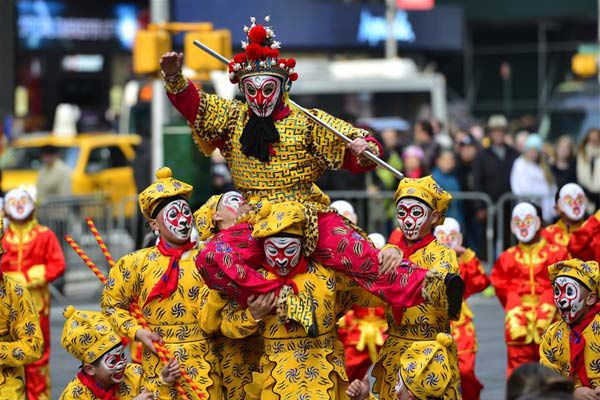
Performers in monkey costumes celebrate the arrival of the Chinese New Year in Times Square in Manhattan, New York, the United States, Feb 6, 2016. The event is an effort to let people from all over the world experience the beauty of Chinese culture, and a move to convey the New Year’s blessings. [Photo/Xinhua]
BEIJING — The Spring Festival traditionally is the most important time of the year for family reunion, but as China has become prosperous, an increasing number of wealthy Chinese are opting to travel abroad, which translates into big business for global retailers.
In the Western world, the traditional shopping season usually lasts a month from Thanksgiving to Christmas holidays. But in recent years, Chinese consumers have managed to add another month to it with the celebration of the Spring Festival, which is as big a deal as Christmas to US malls.
According to the Quartz, South Coast Plaza, the highest-grossing mall in the United States with $1.7 billion in sales in 2015, its peak season begins the day after Thanksgiving and ends not at Christmas but at the close of Chinese New Year celebrations.
At the sprawling shopping center in southern California’s Orange County this week, there are scarlet red dresses on the mannequins at the windows of Carolina Herrera and Balenciaga mainly intended for receiving Chinese customers. Dolce & Gabbana is selling a monkey-print T-shirt, exclusive to the mall, in honor of the Year of the Monkey. Monkey takes the 9th place on the Chinese zodiac circle.
At this time of the year, many US malls, particularly those in West Coast cities with large Asian-American or Asian expatriate communities, feature Chinese Lunar New Year celebrations or decor. But the South Coast Plaza is looking beyond its local clientele to a rapidly-growing base of wealthy Chinese tourists spending serious retail money abroad.
The center has assiduously courted China since the early 2000s, long before that country’s boom in foreign tourism. It was the first shopping center in the US to accept China UnionPay, a Chinese bank card. It was a prescient investment. Chinese shoppers now make up 30 percent of the global luxury goods market, with about half of spending done abroad.
Some economists have predicted that although Americans are still the largest consumers in the world, Chinese consumers will one day have more spending power than Americans with a growing number of middle class.
The Chinese government estimates that 2.91 billion trips of all kinds will be taken over the Chinese Lunar New Year’s 40-day travel season, in what is thought to be the largest yearly movement of people in the world.
This year, overseas visits conducted by Chinese tourists are expected to reach a high of six million over the week-long holiday season that start officially on February 7, according to Ctrip, a major online travel site in the world’s second-largest economy. That represents a 15 percent increase over the total of 5.2 million overseas visits conducted by Chinese tourists over the Lunar New Year season last year.
According to the China National Tourism Administration, Chinese tourists undertook more than 120 million visits overseas in 2015, many of which helped support growth in the countries of destination.
In 2014, Chinese tourists splashed $165 billion overseas, a 28 percent rise from a year ago, the World Tourism Organization found in a report released recently.
Besides the sales of US malls, Chinese tourists also helped to provide a significant boost to Japan’s economy. The Japan Tourism Agency confirmed in a report that Chinese tourists made up 40 percent of total consumption by foreigners in 2015 and spent an average of $2,393 in Japan.
In Japan’s Kobe, celebration of the Chinese Spring Festival and visits by Chinese consumers this year have both added vigor and vitality to Nanjing town, the second largest Chinatown in Japan, as well as economic benefits to the region.
Along the streets, restaurants and shops showed off their cuisine on display stands, hawking about dim sum, dumplings, buns and other traditional Chinese food. Dozens of people lined up in front of a renowned restaurant selling steamed stuffed buns. Two hours passed, and the line was not shortened a bit.
According to the organizer, about 30,000 people were expected to visit every day during the five-day celebration, including not only nostalgic Chinese immigrants, but also Japanese citizens and foreign tourists who are fascinated by Chinese culture.
“Spring Festival celebration has become a grand event for Nanjing town as well as for the city of Kobe. We will continue to hold colorful activities to attract more visitors to Nanjing town,” said Hiroshi Takigawa, head of the executive committee of the Spring Festival celebration of Nanjing town.
As the world is facing daunting challenges including economic downturns, regional turmoils and refugee crises, the Spring Festival and Chinese consumers will bring enormous benefits to the world economy.
